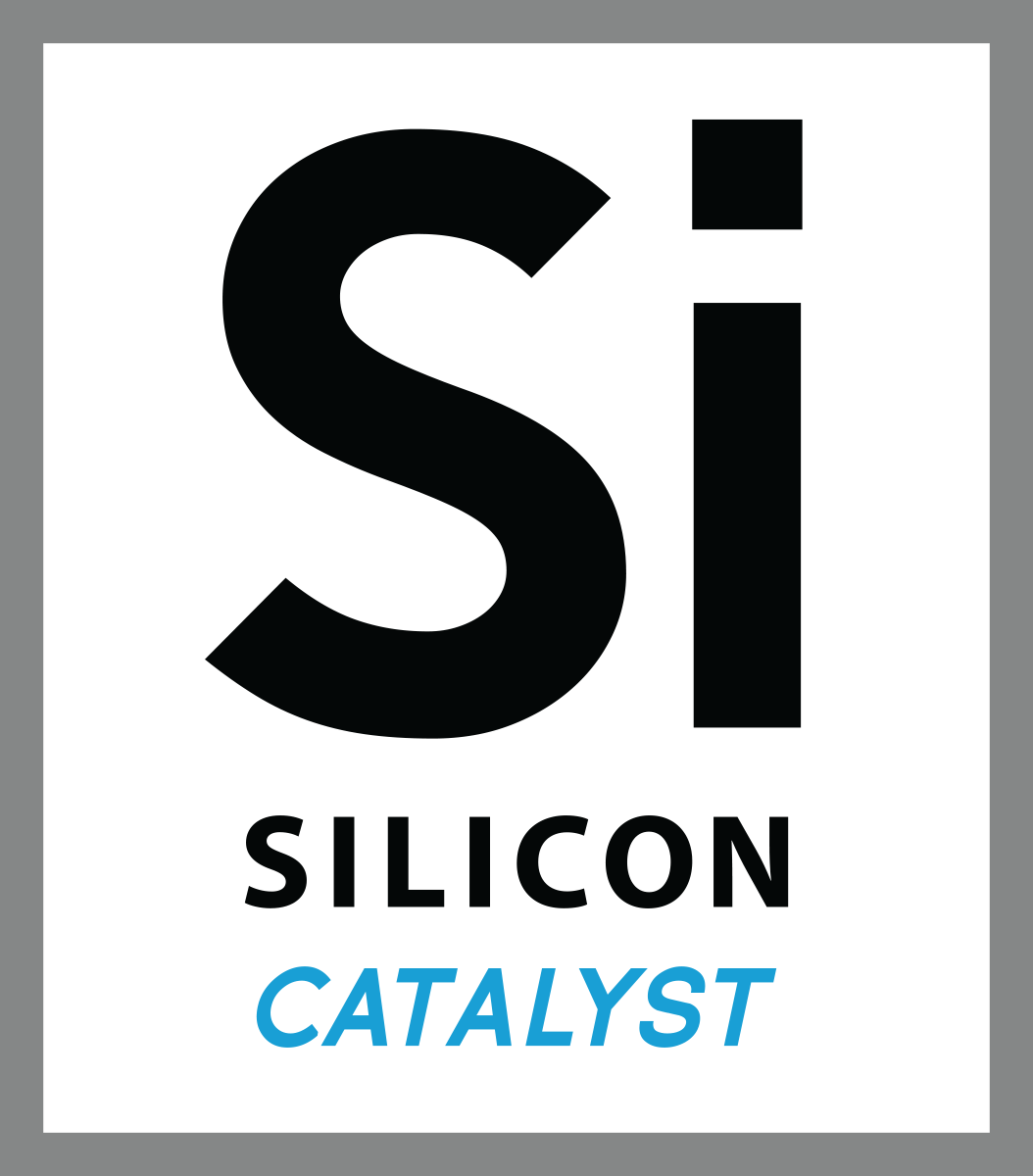August 20, 2018
Silicon Catalyst CEO Pete Rodriguez on the unique proposition of Silicon Catalyst, it’s ecosystem and advisor network
By Cromwell Schubarth – TechFlash Editor, Silicon Valley Business Journal
Rick Lazansky, left, handed the reins at Santa Clara semiconductor incubator Silicon Catalyst to Pete Rodriguez, right, in June.
Lazansky is now chairman and Rodriguez is CEO.
Santa Clara-based Silicon Catalyst bills itself as the world's only incubator that is focused exclusively on semiconductor startups. Some of the companies that it has worked with are just starting to emerge from the three-year-old program that is supported by major players in the chip industry like Texas Instruments and On Semiconductor Corp.
Pete Rodriguez, who was named CEO of the incubator earlier this summer, spoke to the Silicon Valley Business Journal about why it's so hard to do a semiconductor startup, how his program helps and whether Washington's new focus on Chinese chip deals has complicated what it does.
The Q&A has been edited for length and clarity.
Startups in the semiconductor world aren't as frequent as in other sectors. How are you helping with this?
Rick Lazansky, our co-founder and chairman, was at Sand Hill Angels and most of the companies he looked at there were software startups. So, he thought: What can we do to reduce the table stakes and barriers to operations with hardware companies, which can easily involve having to raise millions and millions of dollars. The idea was to make it look more like a software company to an investor. That was kind of the premise to start Silicon Catalyst.
There are fewer hardware startups than software startups, but we have looked at well over 200, probably around 240 now, in the last three years. The heavy consolidation in the semiconductor industry, combined with a focus on reducing R&D, has created opportunity to start a company for people who made money in the consolidation, like at the Qualcomms and Broadcoms of the world. So we have looked at a lot. We haven't selected a lot, but we have looked at a lot.
What's the hardest part of doing a startup in this space and how do you help them get past that?
The hardest part is raising enough money on an idea to get to a prototype. We help reduce that barrier significantly. In the old days, you raised $20 million, you leased an office, you hired engineers, you bought some computers. And then you spent several million dollars on EDA tools. And then six months later when you were done with your first design, you'd spend millions of dollars to build that silicon.
Many of these guys have been doing a design on sweat equity. They've been doing it at home in their garage. So we help them with design tools that they can now use for free for a period of time. We help them with shuttle runs that they can get for free. We help them with tester and tester access and that is a huge part.
When we did a survey before we started, those were the top three problems with getting a company started. Now with our benefits and a little solid equity, you can get to a prototype. So you get to the Series A quicker with much less raised.
Is there a common theme or quality for the ones that you have selected?
We look at the team because they are the ones who will at least take it part of the way. We look at the value proposition, the differentiation and the technology. And then the go-to-market and business plan. If it doesn't make any sense, we provide feedback and try to help, regardless of whether we accept them into the incubator.
We've taken a couple on a test drive basis. We see a couple of holes in their plan that we think we can help them fix over a few months. Then maybe they can apply again. We've done that with a couple of companies.
But, particularly, we look at all the things that a VC does. We have a very deep team. We have hundreds of years of experience, not only as entrepreneurs and technologists in the semiconductor industry, but also as investors and angels.
Is there an investment that comes with being accepted?
At this point, no, although our chairman has personally invested in a handful of the companies, and I've invested in one. We do help our companies raise an investment round to accelerate what we see as a great opportunity. We are also raising a fund that will invest in Series A or Series B rounds. About 7 percent or 8 percent of the companies that come in are all pipe-lined.
But we do provide free or greatly reduced in-kind services that are as good as cash. We believe our companies get on the order of about $2 million in business services from us. It may not be cash in the form of a check. But it's as good as cash. In the case of some of our foreign companies, they've been able to go to their government and get matching grants based on the in-kinds and services that we've given them. That’s harder to do in the U.S., but we have helped companies get DARPA grants.
Where has the money come from that you have operated with for the first few years?
That has been a combination of three things. We have grown to 25 in-kind partners, including Taiwan Semiconductor, Synopsys, Keysight, Ansys, MathWorks and Autodesk. Our in-kind partners have been very kind in terms of making office space available to us and lot of marketing, etc.
In addition, we have a couple of strategic partners — Texas Instruments and On Semiconductor — and we plan on growing that. Our strategic partners help fund operations.
In addition to that, as our companies become more mature, they raise a certain amount of funding. We take back a very small amount in program fees from them. We've got a few of those in place today.
Finally, most of the team are guys that have worked 30-plus years in the industry and have done pretty well. They're not working completely for charity, there is some equity in lieu of salaries that has gone on.
Is there a common flaw that you see in the companies that you don't accept?
There isn't one common flaw. But the most common is that they don't have a good handle on their value proposition. They don't know specifically what the value is that they're going to sell to their customers, how this is significantly better or fills a hole that the customer has. They don’t know what they're going to price it at or how they're going to go to market with it.
They’re mostly pitching the technology versus how the technology fits in the product, how the product fits in the marketplace and how to price it to win in the marketplace.
You have been operating Silicon Catalyst for about three years now. Have there been any graduates?
We actually had a couple of the companies graduate. Another couple are in the process of graduating. There's a couple that we may extend for a period of time if we believe that we can add real value and they believe we can add real value and they're easy to work with. If it's a win-win, then we can extend them for a period of time. Not forever, obviously, but maybe another six months to a year. Possibly that's probably one in three, one in four that we will end up doing that way.
Tell me about your graduates.
One is Ayar Labs, which is miniaturizing fiber optic transceivers and making them in silicon chips. The other is Aeponyx, a fabless micro optical switch semiconductor startup designing and manufacturing chips for fiber optic access to the cloud.
We don’t focus on any specific part of the semiconductor industry. We focus on what we call silicon solutions. Frankly, we'll take any semiconductor startup, not just ones working in silicon. But semiconductor seems to be an ugly word when you talk to VCs and others.
Companies in our portfolio (include businesses) like Eridan Communications, which is building a broad-based transceiver that could definitely revolutionize 5G technology. It could help with defense and first responders by replacing 40 pounds worth of radios with one radio the size of your cell phone.
Ayar Labs is doing silicon photonics for networks and data centers. Zeno is doing a one-piece cell SRAM and they have IP in multiple modes of silicon and major foundries. Probius is doing an electrical array that could smell out E. coli in a small sample, which would be very important for food safety. We have a couple of AI companies. We have a company that has a unique solution for reducing power in displays. We have another company that has a very low-power radio, with high bandwidth.
We're looking for companies that have an e-solution. What we mean by that is they have a solution that is the chip-plus-software, or chip-plus-a-sensor, or chip-plus-a-system, or any combination of those — not just a jelly bean piece of silicon. When they come out of the incubator, we expect that their value proposition is stronger and clearer, their strategy is clearer. They will have a prototype in hand that they can either sell to customers or have started selling to customers. And that they're either getting close to landing a Series A.
One thing you say you have helped your portfolio companies with is getting set up in China. It seems like it's getting more complicated these days to do almost anything in the semiconductor space that involves China. Has increased focus on deals like that complicated what you're doing?
No, because in our case, we're actually getting ownership of companies there. We're not transferring any IP. We're transferring some know-how in terms of how to screen companies and how to select companies and how to help companies. But we're not transferring any intellectual property. We're actually getting ownership in Chinese intellectual property.
From a U.S. government standpoint we're actually getting things from there. From a Chinese government standpoint, we're helping incubate their companies. So I think this is kind of win-win. We hope that once all the saber-rattling is done, we get back to regular business in some period of time.
But, again, to specifically answer your question on China: I think if we were to try to sell our U.S. companies to China that would be a problem, or if we were to transfer IP from here to there, that could be a problem.
And vice versa. But, I think in what we're doing, we're trading some know-how in terms of how to screen companies and incubate them for ownership in Chinese companies. That's U.S. ownership of Chinese companies. So, I think it's kind of a win-win.
About Silicon Catalyst
It’s About What’s Next® - Silicon Catalyst is the world’s only incubator focused exclusively on accelerating solutions in silicon, building a coalition of in-kind and strategic partners to dramatically reduce the cost and complexity of development. Close to 300 startup companies have engaged with Silicon Catalyst since April 2015, with a total of 21 startup and early-stage companies admitted to the incubator. With a world-class network of mentors to advise startups, Silicon Catalyst is helping new semiconductor companies address the challenges in moving from idea to realization. The incubator/accelerator supplies startups with a path to design tools, silicon devices, networking, access to funding, banking and marketing acumen to successfully launch and grow their companies’ novel technology solutions.


